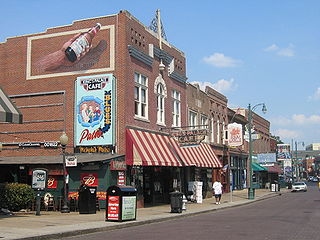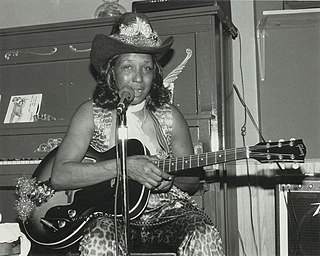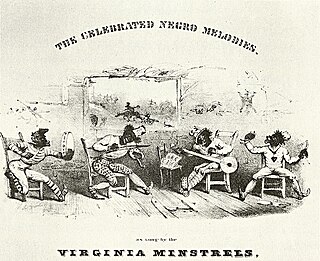
Blues is a music genre and musical form that originated in the Deep South of the United States around the 1860s. Blues incorporated spirituals, work songs, field hollers, shouts, chants, and rhymed simple narrative ballads from the African-American culture. The blues form is ubiquitous in jazz, rhythm and blues, and rock and roll, and is characterized by the call-and-response pattern, the blues scale, and specific chord progressions, of which the twelve-bar blues is the most common. Blue notes, usually thirds, fifths or sevenths flattened in pitch, are also an essential part of the sound. Blues shuffles or walking bass reinforce the trance-like rhythm and form a repetitive effect known as the groove.

Robert Leroy Johnson was an American blues musician and songwriter. His landmark recordings in 1936 and 1937 display a combination of singing, guitar skills, and songwriting talent that has influenced later generations of musicians. Although his recording career spanned only seven months, he is recognized as a master of the blues, particularly the Delta blues style, and one of the most influential musicians of the 20th century. The Rock and Roll Hall of Fame describes him as maybe "the first ever rock star".

William Christopher Handy was an American composer and musician who referred to himself as the Father of the Blues. He was one of the most influential songwriters in the United States. One of many musicians who played the distinctively American blues music, Handy did not create the blues genre but was the first to publish music in the blues form, thereby taking the blues from a regional music style with a limited audience to a new level of popularity.

"When the Levee Breaks" is a country blues song written and first recorded by Memphis Minnie and Kansas Joe McCoy in 1929. The lyrics reflect experiences during the upheaval caused by the Great Mississippi Flood of 1927.

"The Saint Louis Blues" is a popular American song composed by W. C. Handy in the blues style and published in September 1914. It was one of the first blues songs to succeed as a pop song and remains a fundamental part of jazz musicians' repertoire. Benny Goodman, Louis Armstrong, Cab Calloway, Bing Crosby, Bessie Smith, Eartha Kitt, Count Basie, Glenn Miller, Guy Lombardo, Peanuts Hucko, and the Boston Pops Orchestra are among the artists who have recorded it. The song has been called "the jazzman's Hamlet". Composer William Grant Still arranged a version of the song in 1916 while working with Handy.

Beale Street is a street in Downtown Memphis, Tennessee, which runs from the Mississippi River to East Street, a distance of approximately 1.8 miles (2.9 km). It is a significant location in the city's history, as well as in the history of blues music. Today, the blues clubs and restaurants that line Beale Street are major tourist attractions in Memphis. Festivals and outdoor concerts frequently bring large crowds to the street and its surrounding areas.

Jessie Mae Hemphill was an American electric guitarist, songwriter, and vocalist specializing in the North Mississippi hill country blues traditions of her family and regional heritage.
Little is known about the exact origin of the music now known as the blues. No specific year can be cited as the origin of the blues, largely because the style evolved over a long period and existed in approaching its modern form before the term blues was introduced and before the style was thoroughly documented. Ethnomusicologist Gerhard Kubik traces the roots of many of the elements that were to develop into the blues back to the African continent, the "cradle of the blues". One important early mention of something closely resembling the blues comes from 1901, when an archaeologist in Mississippi described the songs of black workers which had lyrical themes and technical elements in common with the blues.

Frank Stokes was an American blues musician, songster, and blackface minstrel, who is considered by many musicologists to be the father of the Memphis blues guitar style.
"Corrine, Corrina" is a 12-bar country blues song in the AAB form. "Corrine, Corrina" was first recorded by Bo Carter. However, it was not copyrighted until 1932 by Armenter "Bo Carter" Chatmon and his publishers, Mitchell Parish and J. Mayo Williams. The song is familiar for its opening verse:

Hokum is a particular song type of American blues music—a song which uses extended analogies or euphemistic terms to make humorous, sexual innuendos. This trope goes back to early dirty blues recordings, enjoyed a huge commercial success in 1920s and 1930s, and is used from time to time in modern American blues and blues rock.

"Dallas Blues", written by Hart Wand, is an early blues song, first published in 1912. It has been called the first true blues tune ever published. However, two other 12-bar blues had been published earlier: Anthony Maggio's "I Got the Blues" in 1908 and "Oh, You Beautiful Doll", a Tin Pan Alley song whose first verse is twelve-bar blues, in 1911. Also, two other songs with "Blues" in their titles were published in 1912: "Baby Seals Blues", a vaudeville tune written by Franklin "Baby" Seals, and "The Memphis Blues", written by W.C. Handy. Neither, however, were genuine blues songs.

"Livery Stable Blues" is a jazz composition copyrighted by Ray Lopez and Alcide Nunez in 1917. It was recorded by the Original Dixieland Jass Band on February 26, 1917, and, with the A side "Dixieland Jass Band One-Step" or "Dixie Jass Band One-Step", became widely acknowledged as the first jazz recording commercially released. It was recorded by the Victor Talking Machine Company in New York City at its studio at 46 West 38th Street on the 12th floor – the top floor.
"Make Me a Pallet on the Floor" is a blues/jazz/folk song. It is considered a standard. Jelly Roll Morton explained the title: "A pallet is something that – you get some quilts – in other words, it's a bed that's made on a floor without any four posters on 'em."
Kid Bailey was a Mississippi Delta bluesman. His one known recording session occurred on September 25, 1929, in Memphis, Tennessee.
Dan Sane was an American Memphis blues and country blues guitarist and songwriter. He was an associate of Frank Stokes. According to the Music journalist Jason Ankeny, "they had emerged among the most complementary duos in all of the blues, with Sane's flatpicking ideally embellished by Stokes' fluid rhythms." The best-known of the songs written by Sane are "Downtown Blues" and "Mr. Crump Don't Like It." His surname was sometimes spelled "Sain".
Wade Walton was an American blues musician and local civil rights leader from Mississippi. He was also a renowned barber, who counted many famous musicians amongst his friends, colleagues, and customers.
Louise Johnson was an American Delta blues singer and pianist, who was active in the 1920s and 1930s. From her brief recording career, Johnson completed four songs during a famed recording session in 1930 which included Charley Patton, Son House, and Willie Brown. Little else is known about her, although Johnson's self-accompaniment during the session is stylistically unique among female musicians of the era.












